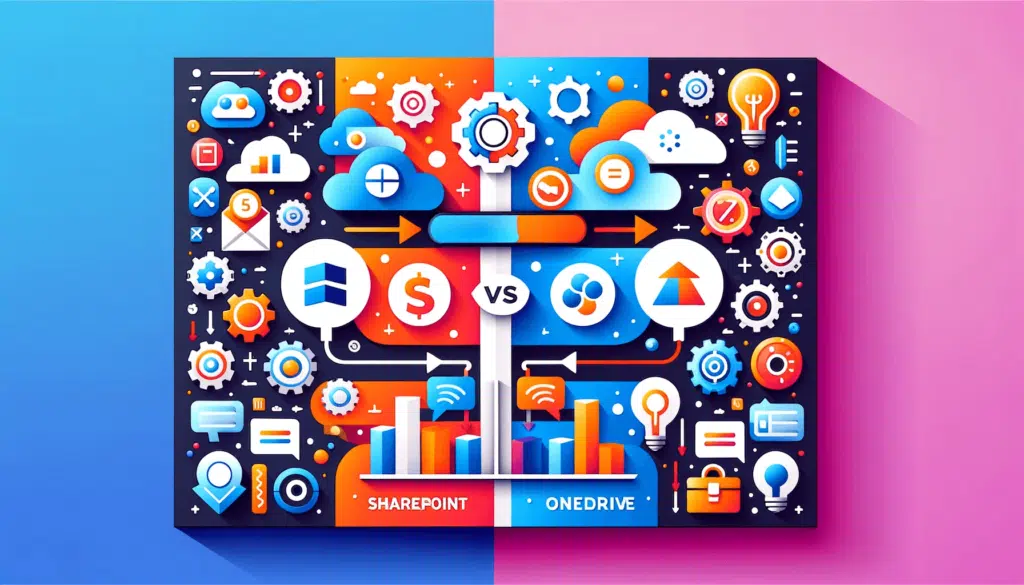Last Updated on June 9, 2024
How does SharePoint differ from OneDrive?
In this article, let’s compare SharePoint and OneDrive, and talk about their pros and cons against each other.
Let’s get started.
Table of Contents:
SharePoint is a powerful platform developed by Microsoft for document management and team collaboration.
It is widely used by enterprises to create intranets, manage content, and facilitate team workflows.
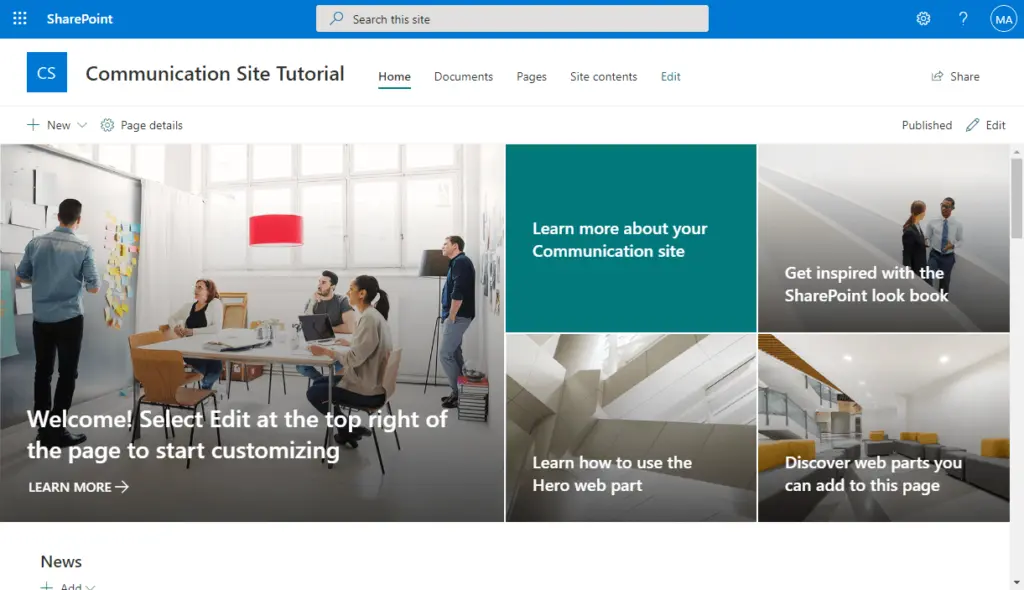
Key Features:
- Team sites: Create dedicated spaces for teams to share documents, collaborate on projects, and manage tasks.
- Document libraries: Store and organize documents in a central location, making it easy for teams to find and access files.
- Workflows: Automate business processes and tasks to improve efficiency and consistency.
- Integration with Microsoft Office: Seamlessly work with other Microsoft applications like Word, Excel, and Outlook.
- Version control: Track changes to documents over time, allowing users to revert to previous versions if needed.
- Advanced security: Protect sensitive information with encryption, access controls, and compliance features.
- Customization: Customize SharePoint sites to fit specific business needs with custom workflows, templates, and branding options.
The platform can be deployed on-premises or used as a cloud-based service through SharePoint Online.
Its scalability ensures it can grow with your organization, accommodating increasing amounts of data and users over time
👉 Related: SharePoint Tips for Beginners: Easy Guide for Newbies
Sign up for exclusive updates, tips, and strategies
What is OneDrive?
OneDrive is an online storage service where you can save your files in the cloud and easily get them from any device.
It’s designed for both personal and business use as a secure and convenient way to manage documents and collaborate.

Key Features:
- File syncing: Automatically sync files across devices, ensuring you always have the latest version available.
- Cross-platform access: Access your files from Windows, Mac, iOS, and Android devices through the OneDrive app or web interface.
- Collaboration tools: Share files and folders with others, enabling real-time collaboration and co-authoring on documents.
- Version history: Keep track of changes to files and revert to previous versions if needed.
- Security measures: Protect your data with encryption, two-factor authentication, and compliance with industry standards.
- Integration with Microsoft 365: Seamlessly integrate with Office apps like Word, Excel, and PowerPoint for easy document creation and editing.
OneDrive comes in two versions:
- OneDrive Personal
- OneDrive for Business
OneDrive Personal is ideal for individual users to store and manage personal files like photos and documents.
OneDrive for Business offers enhanced features for team collaboration, making it suitable for companies and organizations.
👉 Related: How to Use OneDrive: The Ultimate Beginner’s Guide
SharePoint has a lot of pros and cons.
But this time, I want to mention those that can be directly related to SharePoint vs OneDrive.
Robust document management
SharePoint offers more advanced document management features compared to OneDrive.
It allows users to:
- Manage versions
- Set metadata
- Create workflows
For example, a large corporation can use SharePoint to handle complex document approval processes.
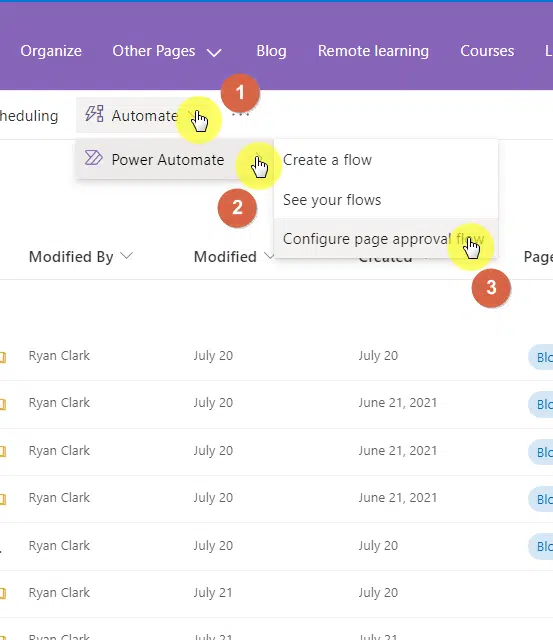
This ensures every document version is tracked and approved by relevant stakeholders.
Enhanced team collaboration
SharePoint excels in facilitating team collaboration with its comprehensive suite of tools.
Unlike OneDrive, which is more focused on individual file storage, SharePoint provides team sites where members can:
- Collaborate on projects
- Share documents
- Manage tasks collectively
This makes SharePoint ideal for projects requiring extensive teamwork and communication.
Customization and integration
SharePoint allows for significant customization and integration with other business applications.
Users can create:
- Custom workflows
- Templates
- Branded team sites
All that to match their specific business processes.
OneDrive offers less flexibility in customization, making SharePoint a better choice for those with unique requirements.
Complexity in setup and management
Setting up and managing SharePoint can be more complex and time-consuming than OneDrive.
SharePoint’s extensive features and customization options require a higher level of expertise and IT involvement.
For smaller businesses or those without a dedicated IT team, OneDrive’s simpler setup might be more appealing.
Higher costs for advanced features
SharePoint often comes with higher costs, especially for on-premises deployments or advanced features.
OneDrive, being simpler and more focused on storage, tends to be more cost-effective.
For organizations with budget constraints, the additional expense of SharePoint may not justify the benefits.
Steeper learning curve
SharePoint has a steeper learning curve compared to OneDrive.
Its extensive features and functionalities require more training for users to fully utilize.
For example:
- Employees might need additional time to become proficient in SharePoint’s document management and workflow capabilities
- Whereas OneDrive’s user-friendly interface allows for quicker adoption
👉 Related: SharePoint Online Deployment Guide: Step-By-Step Tutorial
Pros and Cons of OneDrive
Now let’s check out the side of OneDrive:
Simplicity and ease of use
OneDrive is known for its straightforward setup and user-friendly interface.

Unlike SharePoint, OneDrive allows users to start storing and sharing files quickly.
This makes it an ideal choice for individuals and small businesses looking for an easy-to-use cloud storage solution.
Cost-effective solution
OneDrive often comes at a lower cost compared to SharePoint, particularly for basic storage needs.
OneDrive for Business offers competitive pricing with various plans tailored to different user requirements.
For organizations with tight budgets:
OneDrive provides a cost-effective way to store and share files without the higher expenses associated with SharePoint.
Seamless integration with Microsoft Office
OneDrive integrates seamlessly with Microsoft Office applications.
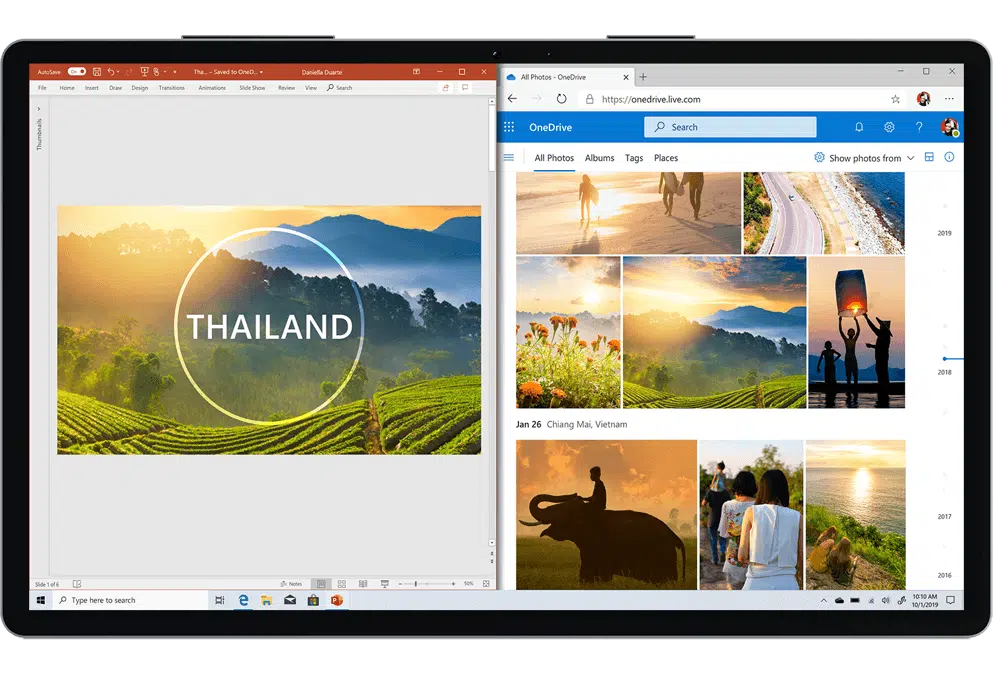
This allows users to easily create, edit, and share documents directly from tools like:
- Word
- Excel
- PowerPoint
While SharePoint also integrates with Microsoft Office, OneDrive’s simpler interface makes this process more intuitive.
Limited advanced features
On the downside, OneDrive lacks advanced features such as:
- Customizable workflows
- Detailed document management capabilities
Those that require extensive document versioning, metadata tagging, and automated processes may find OneDrive insufficient.
SharePoint’s advanced features are more suited for complex organizational needs.
Less robust collaboration tools
OneDrive is primarily designed for individual cloud-based file storage and basic collaboration.
On the other hand, SharePoint offers a broader range of collaboration tools.
For example, SharePoint provides team sites and project management features that are not available in OneDrive.
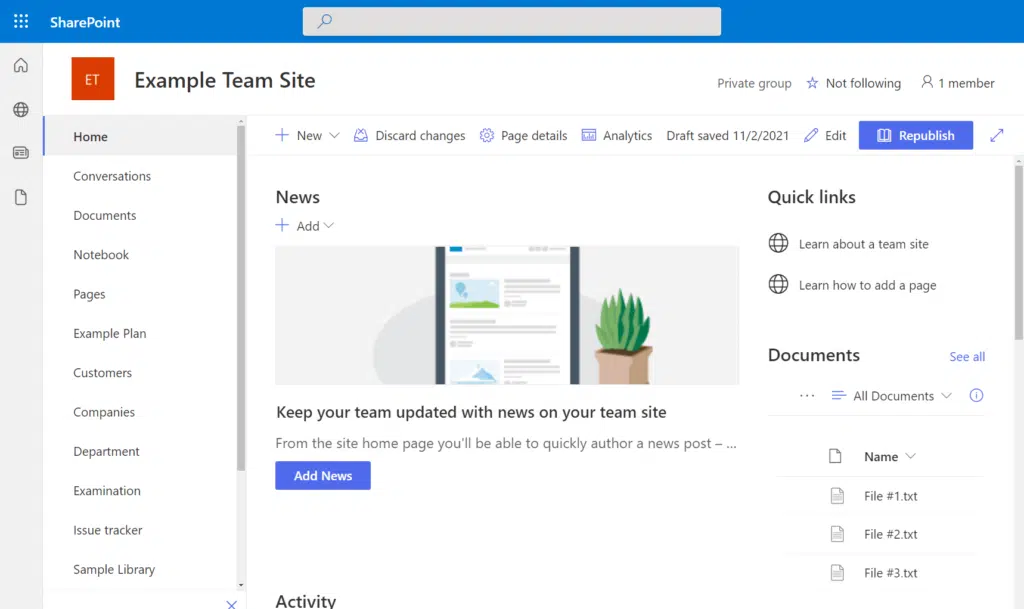
Organizations that need comprehensive collaboration capabilities might find SharePoint a better fit.
Limited customization options
OneDrive offers fewer customization options compared to SharePoint.
While it is excellent for straightforward file storage and sharing, it doesn’t allow for extensive customization.
SharePoint’s ability to customize and integrate with other business applications makes it more versatile for businesses.
If you’re not sure when to get SharePoint:
1. Complex document management
As I explained, SharePoint is ideal for those who need advanced document management capabilities.
It offers features like the following:
- Version control: Keep track of changes and revert to previous versions when necessary.
- Metadata tagging: Organize documents with custom tags for easy retrieval and sorting.
- Automated workflows: Streamline approval processes and other repetitive tasks.
The document management system helps maintain organization and efficiency in handling large volumes of documents.
It’s especially useful for industries with strict regulatory requirements, where document tracking and control are essential.
👉 Related: How to Use Document ID in SharePoint to Track Documents
2. Team collaboration on projects
SharePoint provides tools that help teams work together effectively, manage tasks, and share resources.
Here are some of these tools
- Team sites: Create dedicated spaces for project teams to collaborate.
- Task management: Assign, track, and update tasks to ensure project progress.
- Resource sharing: Share files, calendars, and other resources within the team site.
SharePoint enhances team productivity by:
- Centralizing project-related information
- Providing a structured environment
This makes it an excellent choice for project managers and teams working on multi-faceted projects.
3. Customizable business solutions
SharePoint is suitable for businesses that need customized solutions to meet specific operational needs.
It allows extensive customization and integration with other business applications using:
- Custom workflows: Design workflows that fit your unique business processes.
- Integration with other apps: Connect SharePoint with various third-party and Microsoft applications.
- Customizable templates: Use or create templates to match your branding and operational requirements.
SharePoint can be customized to fit a wide range of industries and business models.
When to use OneDrive?
For OneDrive:
1. Simple file storage and sharing
OneDrive is perfect for users who need a straightforward solution for storing and sharing files.
Its simplicity makes it accessible to individuals and small businesses because of its:
- Easy setup: Get started quickly without complex configurations.
- File sharing: Share documents and folders with a few clicks.
- Access anywhere: Retrieve your files from any device with internet access.
OneDrive is ideal for those who need reliable cloud storage without the complexity of more advanced systems.
It’s a good choice for personal use and small teams that don’t require extensive collaboration tools.
2. Seamless integration with Microsoft Office
As I explained earlier, OneDrive works seamlessly with Microsoft Office applications.
This makes it an excellent choice for users who frequently work with Office documents because of:
- Direct editing: Edit Word, Excel, and PowerPoint files directly from OneDrive.
- Real-time collaboration: Work with others on Office documents simultaneously.
- Automatic saving: Save changes in real time to prevent data loss.
OneDrive’s integration with Microsoft Office enhances productivity for users who rely on these tools.
It allows for smooth transitions between creating, editing, and sharing documents, making it a convenient option.
3. Cost-effective cloud storage
OneDrive offers a cost-effective solution for those needing cloud storage.
That’s without the additional features and costs associated with more complex platforms.
- Affordable plans: Choose from various pricing plans to fit your budget.
- Free storage: Take advantage of free storage space with a Microsoft account.
- Business plans: Opt for business plans that provide more storage and features at competitive prices.
OneDrive’s affordability makes it accessible to a wide range of users, from individuals to small businesses.
The free storage option is particularly beneficial for those who need basic cloud storage without incurring additional costs.
Cost Comparison
Microsoft offers several plans tailored for businesses, each with varying features and prices.
Here’s a quick comparison of the key business plans available:
| Plan | Price per User/Month (Annual Subscription) | Features |
| OneDrive for Business (Plan 1) | $5.00 | 1 TB of OneDrive storage, file sharing, and collaboration tools |
| SharePoint (Plan 1) | $5.00 | 1 TB per user, team sites, basic collaboration features |
| Microsoft 365 Business Basic | $6.00 | Web and mobile versions of Office apps, 1 TB of OneDrive storage, Microsoft Teams |
| Microsoft 365 Business Standard | $12.50 | All features of Business Basic, plus desktop versions of Office apps, and additional business tools |
| Microsoft 365 Business Premium | $22.00 | All features of Business Standard, plus advanced security and device management |
| Microsoft 365 Apps for Business | $8.25 | Desktop versions of Office apps, 1 TB of OneDrive storage, and basic support services |
When selecting between OneDrive and SharePoint for business, it’s important to consider your organization’s specific needs.
- OneDrive for Business offers straightforward cloud storage solutions suitable for small to medium-sized businesses.
- SharePoint, however, provides more advanced collaboration features and greater customization.
SharePoint is better for larger organizations or those needing detailed document management and team collaboration.
The Microsoft 365 Business plans integrate both OneDrive and SharePoint features, along with other Office apps.
The choice between Business Basic, Standard, and Premium plans should be based on the:
- Required level of security
- Device management
- Access to desktop apps
On the bright side, it’s hard to go wrong with any of the business plans.
Anyway, got any questions about how SharePoint and OneDrive differ? Let me know below.
For any business-related queries or concerns, contact me through the contact form. I always reply. 🙂

